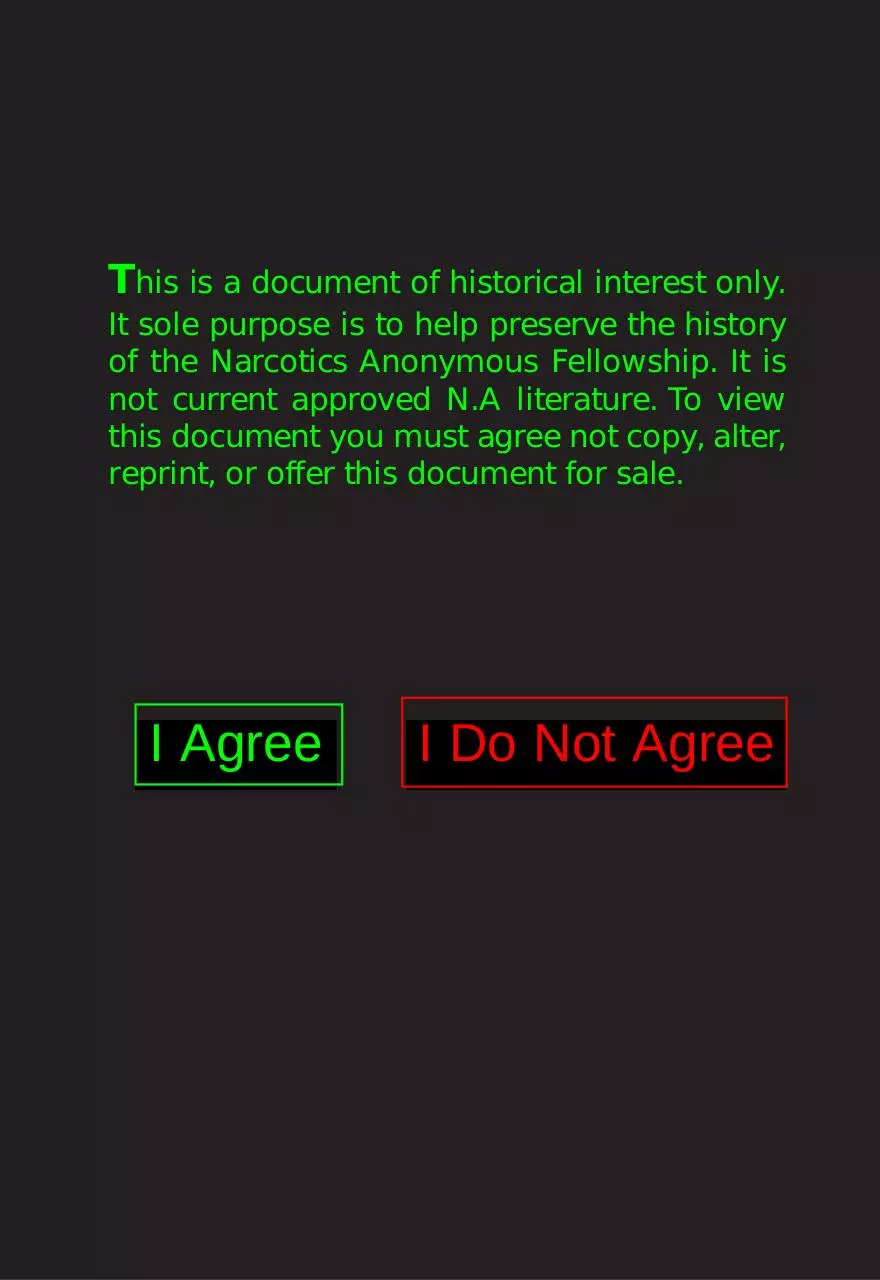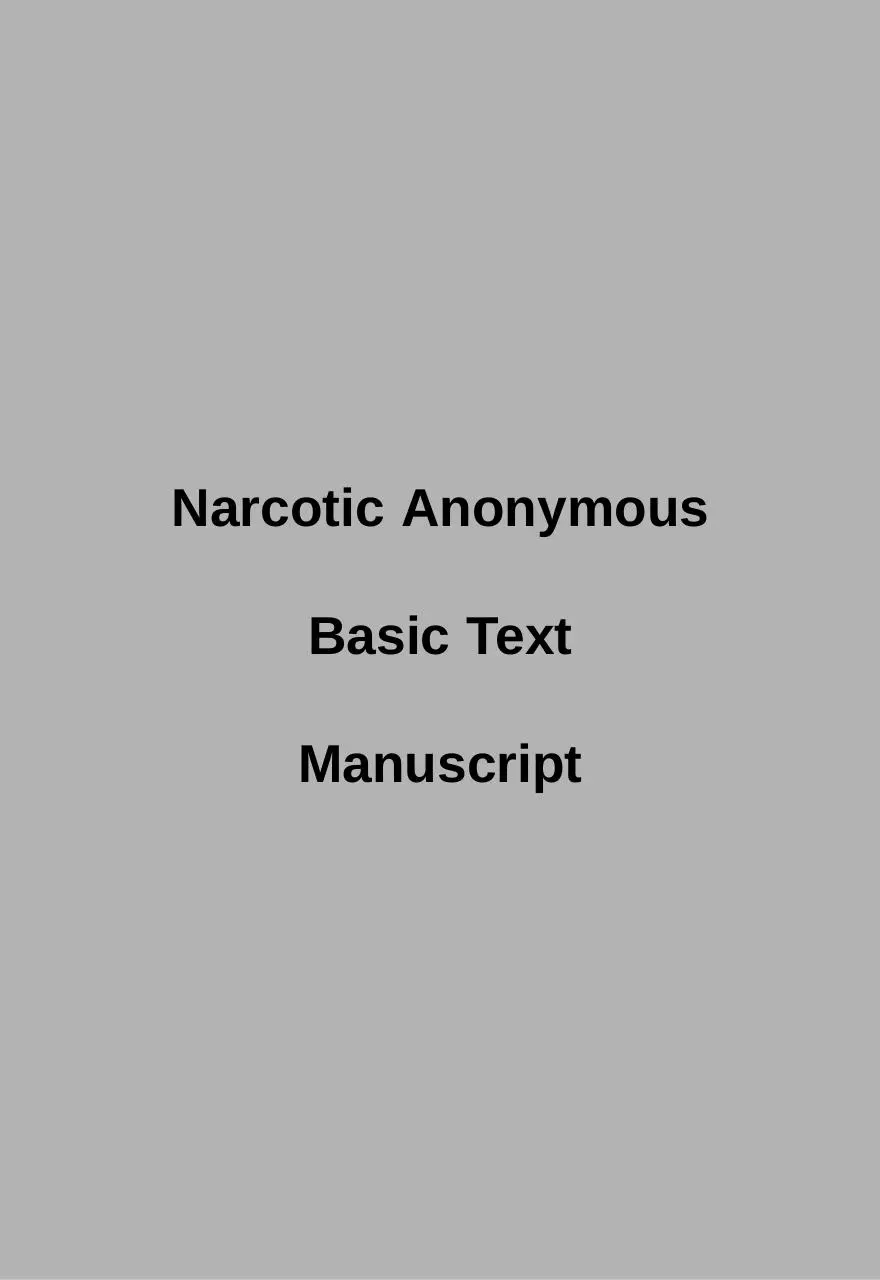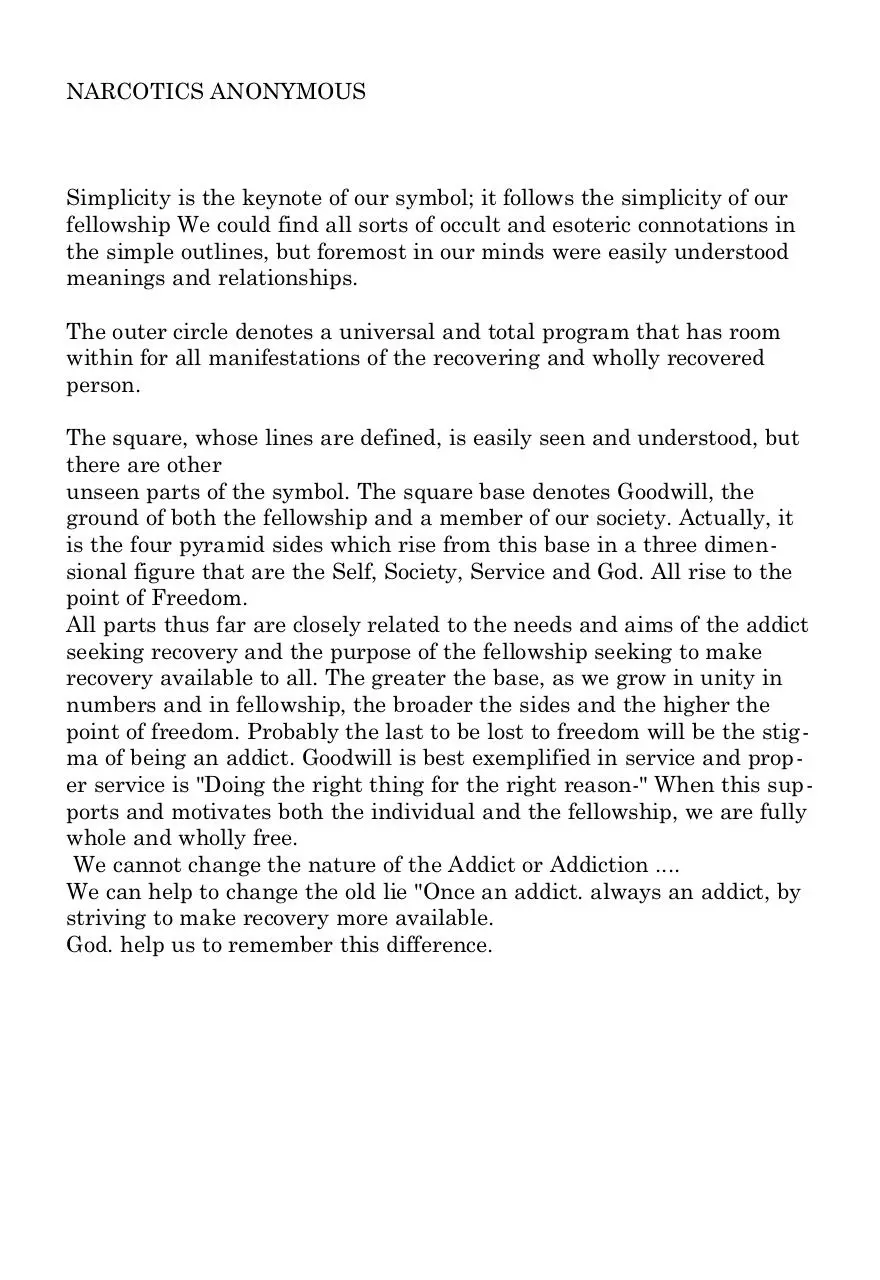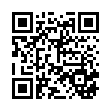orig greybook (PDF)
File information
Title: N.A. Basic Text Original Manuscript
Author: Fellowship of Narcotics Anonymous
This PDF 1.2 document has been generated by PSCRIPT.DRV Version 4.0 / Acrobat Distiller 3.0 for Windows, and has been sent on pdf-archive.com on 04/07/2017 at 23:19, from IP address 167.114.x.x.
The current document download page has been viewed 5941 times.
File size: 309.86 KB (122 pages).
Privacy: public file





File preview
This is a document of historical interest only.
It sole purpose is to help preserve the history
of the Narcotics Anonymous Fellowship. It is
not current approved N.A literature. To view
this document you must agree not copy, alter,
reprint, or offer this document for sale.
I Agree
I Do Not Agree
Narcotic Anonymous
Basic Text
Manuscript
NARCOTICS ANONYMOUS
Simplicity is the keynote of our symbol; it follows the simplicity of our
fellowship We could find all sorts of occult and esoteric connotations in
the simple outlines, but foremost in our minds were easily understood
meanings and relationships.
The outer circle denotes a universal and total program that has room
within for all manifestations of the recovering and wholly recovered
person.
The square, whose lines are defined, is easily seen and understood, but
there are other
unseen parts of the symbol. The square base denotes Goodwill, the
ground of both the fellowship and a member of our society. Actually, it
is the four pyramid sides which rise from this base in a three dimensional figure that are the Self, Society, Service and God. All rise to the
point of Freedom.
All parts thus far are closely related to the needs and aims of the addict
seeking recovery and the purpose of the fellowship seeking to make
recovery available to all. The greater the base, as we grow in unity in
numbers and in fellowship, the broader the sides and the higher the
point of freedom. Probably the last to be lost to freedom will be the stigma of being an addict. Goodwill is best exemplified in service and proper service is "Doing the right thing for the right reason-" When this supports and motivates both the individual and the fellowship, we are fully
whole and wholly free.
We cannot change the nature of the Addict or Addiction ....
We can help to change the old lie "Once an addict. always an addict, by
striving to make recovery more available.
God. help us to remember this difference.
TABLE OF CONTENTS.
OUR N.A. SYMBOL...........................Frontispiece
FORWARD............................................ I
INTRODUCTION...................................... ii
WHO IS AN ADDICT?...................................1
WHAT IS THE NARCOTICS ANONYMOUS PROGRAM?........... 5
WHY ARE WE HERE?....................................8
HOW IT WORKS...................................... 10
WHAT CAN I DO?.................................... 25
THE TWELVE TRADITIONS OF N.A. .....................28
RECOVERY AND RELAPSE...............................37
WE DO RECOVER......................................41
JUST FOR TODAY.....................................44
MORE WILL BE REVEALED..............................46
FORWARD
"The full fruit of a labor of love lives in the harvest, and that always
comes in its right season..."
The material for this book was drawn from the personal experiences of
recovering addicts within the Fellowship of Narcotics Anonymous. The
text is based on an outline derived from the pamphlet (our "white
book"), "Narcotics Anonymous." The first eight chapters are based on
the topic headings in the it white book" and carry the same title. We
have included a ninth chapter, 'Just for Today,' and a tenth chapter,
'More Will Be Revealed.' The remainder of the text was comprised of
personal stories and appendices.
Following is a brief history of the book
Narcotics Anonymous was formed in July 1953 with the first meeting
held in Southern California. The Fellowship grew erratically, but quickly spread to various parts of the United States. From the beginning
while membership was still very small and the need was seen for a
"book on recovery" to help strengthen the Fellowship. The pamphlet,
"Narcotics Anonymous," was published in 1962.
However, the Fellowship still had little structure and the 1960's were a
period of struggle. Membership grew rapidly for a time, and then began
to decline. The need for more specific direction was readily apparent.
N.A. demonstrated its maturity in 1972 when a World Service Office
was opened in Los Angeles. The W.S.O. has brought the needed unity
and sense of purpose to the Fellowship.
The opening of W.S.O. brought stability to the growth of the Fellowship.
Today, there are many thousand recovering addicts in hundreds of
meetings all across the United States and in many foreign countries.
Today, the World Service office truly serves a worldwide Fellowship.
Narcotics Anonymous has long recognized the need for a complete text
on addiction - a book about addicts, by addicts and for addicts, which
would serve us much like the A.A. "Big Book" has served that
Fellowship.
This effort was strengthened shortly after the formation of W.S.O. with
the publication of The N.A. Tree, a pamphlet on service work. This
pamphlet the original "service manual" of the Fellowship. It has been
followed by subsequent and more comprehensive volumes, and now the
N.A. Service manual.
The manual outlined a service structure which included a World
Service Conference. The W.S.C., in turn, included a Literature commit-
tee . With the encouragement of W.S.O., several members of the Board
of Trustees and the Conference, work began. As the cry for literature,
particularly a comprehensive text, became more widespread, the W.S.C.
Literature committee developed. In October, 1979, the first, World
Literature Conference was held at Wichita, Kansas, followed by conferences at Lincoln, Nebraska and Memphis, Tennessee.
The W.S.C. Literature Committee, working in conference and as individuals, have collected hundreds of pages of material from members
and groups throughout the Fellowship. This material has been laboriously catalogued, edited, rewritten, assembled, dismembered and
reassembled. Dozens of area and regional representatives working with
the Committee have dedicated weeks and thousands of man-hours to
produce the work here presented. But more importantly, those members have conscientiously sought to insure a "group-conscious" text.
In keeping with the spirit of anonymity, we, the Literature Committee
feel it appropriate to express our special gratitude and appreciation to
the Fellowship as a whole, especially the many c)f you who contributed
material for inclusion in the book. We feel that this book is a synthesis
of the collective Group Conscience of the entire Fellowship and that
every single idea submitted is included in the work, in some form or
another.
This volume is intended as a textbook for every addict seeking recovery.
As addicts, we know the pain of addiction, but we also know the joy of
recovery we have found in the Fellowship and on the program of
Narcotics Anonymous. We believe the time has come to share our recovery in written form with all who desire what we have found.
Appropriately, this book is devoted to informing every addict JUST
FOR TODAY, YOU NEVER HAVE TO USE AGAIN.
Therefore,
"With gratitude in our cleanliness, we dedicate our N.A.book to the loving service of our Higher Power that through the development of conscious contact with God, no addict seeking recovery need die without
having had a chance to find a better way of life."
We remain trusted servants.
In gratitude and loving service,
WORLD LITERATURE CONFERENCE-III
WORLD SERVICE CONFERENCE-LITERATURE COMMITTEE,
NARCOTICS ANONYMOUS At Memphis, Tennessee February 8, 1981
INTRODUCTION
This book is the shared common and personal experience of the
Fellowship of Narcotics Anonymous. We welcome you to read this text,
trusting that you will choose to share with us the new life we have
found. We have by no means found a "cure" for addiction. We offer only
a proven plan for daily recovery.
In N.A., we follow a program adapted from Alcoholics Anonymous. In
the last forty-five years, more than one million people have recovered in
A.A., most of them just as hopelessly addicted to alcohol as we were to
drugs. We are grateful to the A.A. fellowship for showing us the way to
a new life.
The Twelve Steps of Narcotics Anonymous, as adapted from A.A., are
the basis of our recovery program. We have only broadened the perspective of addiction. We follow the same path with a single exception; our
identification as addicts is all-inclusive in respect to any mood-changing, mind- altering substance. "Alcoholism" did not cover the total spectrum as comprehensively as does addiction. We believe that we have
been guided by a Greater Consciousness as a Fellowship, and are grateful for the Direction that has enabled us to build upon an alreadyproven program of recovery.
We have come to Narcotics Anonymous by various means and believe
that as our common denominator is that we failed to come to terms
with our addictions, however varied. Because of the degree and variety
of addictions found within our Fellowship, we have approached the
solution contained within this book in general terms. We pray that we
have been searching and thorough, so that every addict who reads this
volume will find the hope we have found.
Based on our collective experience, we believe that every addict, including the "potential" addict, suffers from an incur- able disease of body,
mind and spirit. We were in the grip of a hopeless dilemma. The solution of which is spiritual in nature. Therefore, this book will deal in
great part with spiritual matters.
We are not a religious organization. our program is a set of spiritual
principles through which we are recovering from a seemingly hopeless
state of mind and body. Throughout the compiling of this work, the prevailing theme has been the conscious prayer and meditation
"GOD, grant us knowledge that we may write according to Your Divine
precepts; instill in us a sense of Your purpose, make us servants of
Your will and grant us a bond of selflessness that this may truly be
Your work, not ours, in order that no addict, anywhere, need die from
the horrors of addiction."
Everything that occurs in. the course of N.A. service must be motivated
by the desire to more successfully carry the message of recovery to the
addict who still suffers. It was for this reason that we began this work.
We must always remember that as individual members, groups, and
service committees, we are not, and should never be, in competition
with each other. We work separately and together to help the newcomer
and for our common good. We have learned, painfully, that internal
strife cripples our Fellowship; it prevents us from providing the services
necessary for growth.
It is our hope that this book will help the suffering addict find the solution we have found. our purpose is to remain clean, just for today, and
to carry the message of recovery..
Thank you,
WORLD LITERATURE CONFERENCE IIIWORLD SERVICE CONFERENCE - LITERATURE COMMITTEE,
NARCOTICS ANONYMOUS
CHAPTER ONE
WHO IS AN ADDICT?
Most of us do not have to think twice about this question. WE KNOW.
Our whole life and thinking is centered in drugs in one form or another,
the getting and using and finding ways and means to get more. We use
to live and live to use. Very simply an addict is a man or woman whose
life is controlled by drugs. We are people in the grip of a continuing and
Progressive illness whose ends are always the same jails, institutions
and death.
The user may be unaware that a problem exists until, for example, the
drugs run out and they begin to feel the early stages of withdrawal. Or,
they keep using but start to notice if they try to stop, that they are
unable, or when using they have lost control over the amount. We
admitted that we used drugs, but many of us did not think we had a
problem.
As practicing addicts, we were keenly aware of the difference between
right and wrong. Many of us were convinced that we were right and the
world was wrong, and used this belief to justify our self-destructive
behavior. Many of us developed a loser's point of view which enabled us
to pursue our addiction without the restraints of concern about our
well-being. Simply, the loser's point of view focuses on the negative in
all things
We realized that our record had not been good, but that was due to
being in the wrong place at the wrong time, or so we thought. We were
yet to realize that our "bad luck" was caused by situations we had
placed ourselves in, through the
As practicing addicts, we could really get down and if we experienced a
periodic jolt of self-awareness, it seemed as if we were two people
instead of one, like Dr. Jekyll and Mr. Hyde. We became capable of
depravity - of betrayal to ourselves and to others. Temporarily clean, we
ran around trying to get it all squared away before our next spree.
Sometimes we could do this very well, but later it seemed less important, and at the same time, more impossible. After years of trying to
make ourselves happy with cars, sex and dope, we were unhappy and
less satisfied than when it all started.
Some of us first saw the effects of addiction in the people we were close
to. We became very dependent on people to carry us emotionally
through life. We were always left disappointed and hurt when they had
other interests, other friends and loved ones. We regretted the past; we
feared the future. We were constantly searching for "the answer"-searching for meaninglessness and purposelessness. While using, we
Download orig greybook
orig_greybook.pdf (PDF, 309.86 KB)
Download PDF
Share this file on social networks
Link to this page
Permanent link
Use the permanent link to the download page to share your document on Facebook, Twitter, LinkedIn, or directly with a contact by e-Mail, Messenger, Whatsapp, Line..
Short link
Use the short link to share your document on Twitter or by text message (SMS)
HTML Code
Copy the following HTML code to share your document on a Website or Blog
QR Code to this page

This file has been shared publicly by a user of PDF Archive.
Document ID: 0000620306.